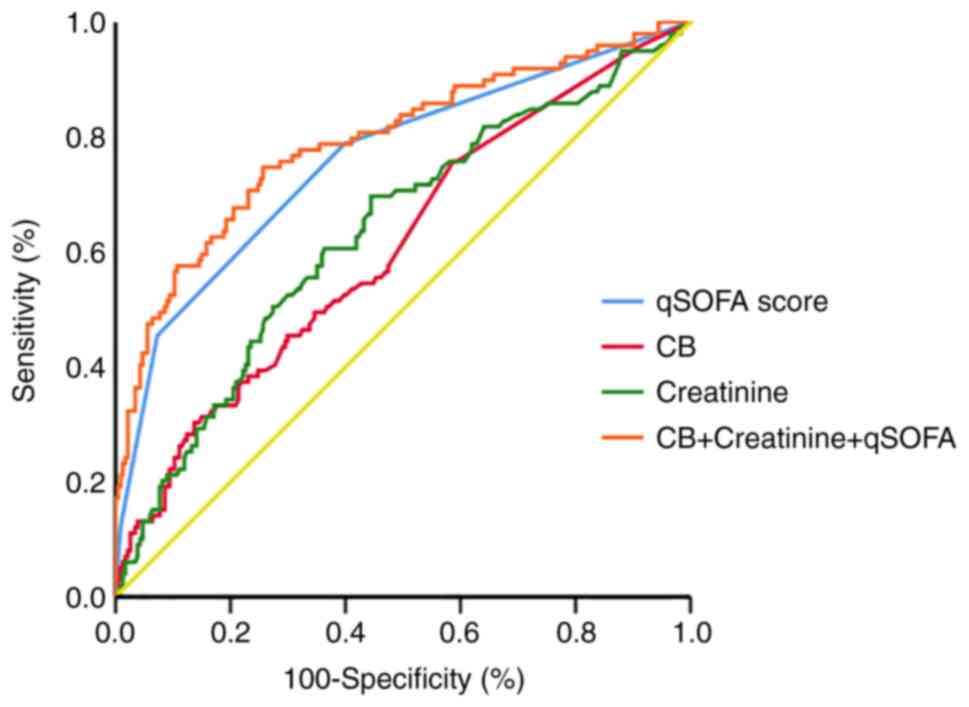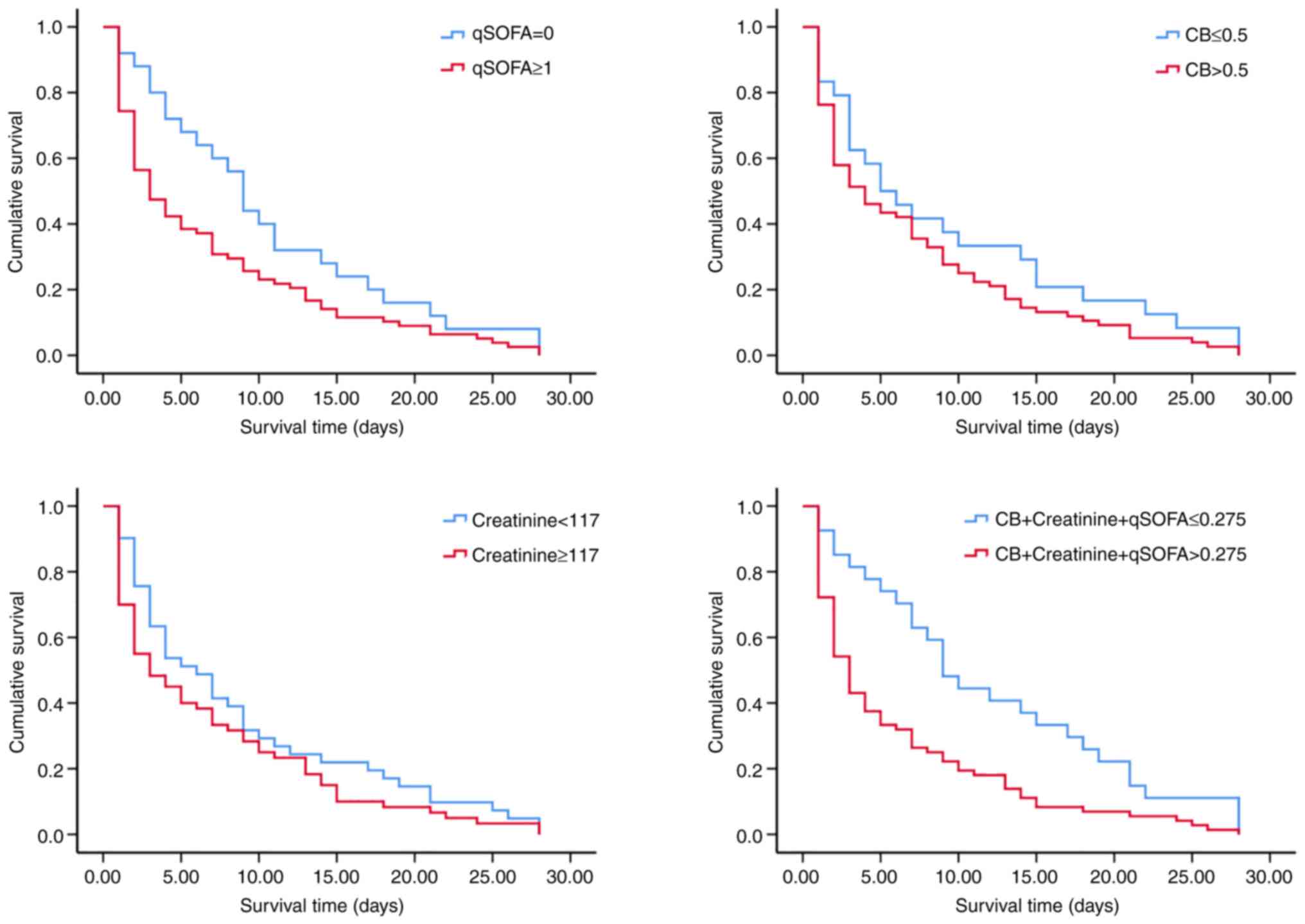|
1
|
Esposito S, De Simone G, Boccia G, De Caro
F and Pagliano P: Sepsis and septic shock: New definitions, new
diagnostic and therapeutic approaches. J Glob Antimicrob Resist.
10:204–212. 2017.PubMed/NCBI View Article : Google Scholar
|
|
2
|
Rudd KE, Johnson SC, Agesa KM, Shackelford
KA, Tsoi D, Kievlan DR, Colombara DV, Ikuta KS, Kissoon N, Finfer
S, et al: Global, regional, and national sepsis incidence and
mortality, 1990-2017: Analysis for the global burden of disease
study. Lancet. 395:200–211. 2020.PubMed/NCBI View Article : Google Scholar
|
|
3
|
Feng J, Wang L, Feng Y, Yu G, Zhou D and
Wang J: Serum levels of angiopoietin 2 mRNA in the mortality
outcome prediction of septic shock. Exp Ther Med.
23(362)2022.PubMed/NCBI View Article : Google Scholar
|
|
4
|
Wang J, Feng Q, Wu Y and Wang H:
Involvement of blood lncRNA UCA1 in sepsis development and
prognosis, and its correlation with multiple inflammatory
cytokines. J Clin Lab Anal. 20(e24392)2022.PubMed/NCBI View Article : Google Scholar
|
|
5
|
Sun T, Wang Y, Wu X, Cai Y, Zhai T and
Zhan Q: Prognostic value of Syndecan-1 in the prediction of
sepsis-related complications and mortality: A meta-analysis. Front
Public Health. 10(870065)2022.PubMed/NCBI View Article : Google Scholar
|
|
6
|
Mierzchala-Pasierb M, Krzystek-Korpacka M,
Lesnik P, Adamik B, Placzkowska S, Serek P, Gamian A and
Lipinska-Gediga M: Interleukin-18 serum levels in sepsis:
Correlation with disease severity and inflammatory markers.
Cytokine. 120:22–27. 2019.PubMed/NCBI View Article : Google Scholar
|
|
7
|
Arora S, Singh P, Singh PM and Trikha A:
Procalcitonin levels in survivors and nonsurvivors of sepsis:
Systematic review and meta-analysis. Shock. 43:212–221.
2015.PubMed/NCBI View Article : Google Scholar
|
|
8
|
Kumar N, Dayal R, Singh P, Pathak S,
Pooniya V, Goyal A, Kamal R and Mohanty KK: A comparative
evaluation of presepsin with procalcitonin and CRP in diagnosing
neonatal sepsis. Indian J Pediatr. 86:177–179. 2019.PubMed/NCBI View Article : Google Scholar
|
|
9
|
Singer M, Deutschman CS, Seymour CW,
Shankar-Hari M, Annane D, Bauer M, Bellomo R, Bernard GR, Chiche
JD, Coopersmith CM, et al: The third international consensus
definitions for sepsis and septic shock (sepsis-3). JAMA.
315:801–810. 2016.PubMed/NCBI View Article : Google Scholar
|
|
10
|
Freund Y, Lemachatti N, Krastinova E, Van
Laer M, Claessens YE, Avondo A, Occelli C, Feral-Pierssens AL,
Truchot J, Ortega M, et al: Prognostic accuracy of sepsis-3
criteria for in-hospital mortality among patients with suspected
infection presenting to the emergency department. JAMA.
317:301–308. 2017.PubMed/NCBI View Article : Google Scholar
|
|
11
|
Juschten J, Bos LDJ, de Grooth HJ, Beuers
U, Girbes ARJ, Juffermans NP, Loer SA, van der Poll T, Cremer OL,
Bonten MJM, et al: Incidence, clinical characteristics and outcomes
of early hyperbilirubinemia in critically Ill patients: Insights
from the MARS study. Shock. 57:161–167. 2022.PubMed/NCBI View Article : Google Scholar
|
|
12
|
Collazos J, de la Fuente B, de la Fuente
J, García A, Gómez H, Menéndez C, Enríquez H, Sánchez P, Alonso M,
López-Cruz I, et al: Factors associated with sepsis development in
606 Spanish adult patients with cellulitis. BMC Infect Dis.
20(211)2020.PubMed/NCBI View Article : Google Scholar
|
|
13
|
Waltz P, Carchman E, Gomez H and
Zuckerbraun B: Sepsis results in an altered renal metabolic and
osmolyte profile. J Surg Res. 202:8–12. 2016.PubMed/NCBI View Article : Google Scholar
|
|
14
|
Song R, Xu N, Luo L, Zhang T and Duan H:
Diagnostic value of aortic dissection risk score, coagulation
function, and laboratory indexes in acute aortic dissection. Biomed
Res Int. 2022(7447230)2022.PubMed/NCBI View Article : Google Scholar
|
|
15
|
Pierrakos C, Velissaris D, Felleiter P,
Antonelli M, Vanhems P, Sakr Y and Vincent JL: EPIC II
investigators. Increased mortality in critically ill patients with
mild or moderate hyperbilirubinemia. J Crit Care. 40:31–35.
2017.PubMed/NCBI View Article : Google Scholar
|
|
16
|
Patel JJ, Taneja A, Niccum D, Kumar G,
Jacobs E and Nanchal R: The association of serum bilirubin levels
on the outcomes of severe sepsis. J Intensive Care Med. 30:23–29.
2015.PubMed/NCBI View Article : Google Scholar
|
|
17
|
Arai T, Yoshikai Y, Kamiya J, Nagino M,
Uesaka K, Yuasa N, Oda K, Sano T and Nimura Y: Bilirubin impairs
bactericidal activity of neutrophils through an antioxidant
mechanism in vitro. J Surg Res. 96:107–113. 2001.PubMed/NCBI View Article : Google Scholar
|
|
18
|
Maruhashi T, Soga J, Fujimura N, Idei N,
Mikami S, Iwamoto Y, Kajikawa M, Matsumoto T, Kihara Y, Chayama K,
et al: Hyperbilirubinemia, augmentation of endothelial function,
and decrease in oxidative stress in Gilbert syndrome. Circulation.
126:598–603. 2012.PubMed/NCBI View Article : Google Scholar
|
|
19
|
Uslu A, Taşli FA, Nart A, Postaci H, Aykas
A, Bati H and Coşkun Y: Human kidney histopathology in acute
obstructive jaundice: A prospective study. Eur J Gastroenterol
Hepatol. 22:1458–1465. 2010.PubMed/NCBI View Article : Google Scholar
|
|
20
|
Brites D and Fernandes A:
Bilirubin-induced neural impairment: A special focus on
myelination, age-related windows of susceptibility and associated
co-morbidities. Semin Fetal Neonatal Med. 20:14–19. 2015.PubMed/NCBI View Article : Google Scholar
|
|
21
|
Lanone S, Bloc S, Foresti R, Almolki A,
Taillé C, Callebert J, Conti M, Goven D, Aubier M, Dureuil B, et
al: Bilirubin decreases nos2 expression via inhibition of NAD(P)H
oxidase: Implications for protection against endotoxic shock in
rats. FASEB J. 19:1890–1892. 2005.PubMed/NCBI View Article : Google Scholar
|
|
22
|
Kundur AR, Bulmer AC and Singh I:
Unconjugated bilirubin inhibits collagen induced platelet
activation. Platelets. 25:45–50. 2014.PubMed/NCBI View Article : Google Scholar
|
|
23
|
Li Y, Huang B, Ye T, Wang Y, Xia D and
Qian J: Physiological concentrations of bilirubin control
inflammatory response by inhibiting NF-κB and inflammasome
activation. Int Immunopharmacol. 84(106520)2020.PubMed/NCBI View Article : Google Scholar
|
|
24
|
Vanwijngaerden YM, Langouche L, Brunner R,
Debaveye Y, Gielen M, Casaer M, Liddle C, Coulter S, Wouters PJ,
Wilmer A, et al: Withholding parenteral nutrition during critical
illness increases plasma bilirubin but lowers the incidence of
biliary sludge. Hepatology. 60:202–210. 2014.PubMed/NCBI View Article : Google Scholar
|
|
25
|
Chen Y, Zhou X and Wu Y: The
miR-26a-5p/IL-6 axis alleviates sepsis-induced acute kidney injury
by inhibiting renal inflammation. Ren Fail. 44:551–561.
2022.PubMed/NCBI View Article : Google Scholar
|
|
26
|
Bellomo R, Kellum JA, Ronco C, Wald R,
Martensson J, Maiden M, Bagshaw SM, Glassford NJ, Lankadeva Y,
Vaara ST and Schneider A: Acute kidney injury in sepsis. Intensive
Care Med. 43:816–828. 2017.PubMed/NCBI View Article : Google Scholar
|
|
27
|
Poston JT and Koyner JL: Sepsis associated
acute kidney injury. BMJ. 364(k4891)2019.PubMed/NCBI View Article : Google Scholar
|
|
28
|
Sun J, Zhang J, Tian J, Virz GM, Digvijay
K, Cueto L, Yin Y, Rosner MH and Ronco C: Mitochondria in
Sepsis-induced AKI. J Am Soc Nephrol. 30:1151–1161. 2019.PubMed/NCBI View Article : Google Scholar
|
|
29
|
Ronco C, Bellomo R and Kellum JA: Acute
kidney injury. Lancet. 394:1949–1964. 2019.PubMed/NCBI View Article : Google Scholar
|
















